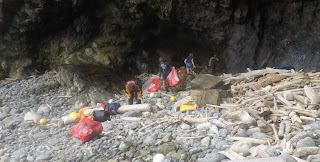It’s
been three and a half weeks in the planning, but today, we made it into the
wick to do a clean-up.
This
was only possible with cooperation with the lovely folk at the Skomer Marine Conservation Zone (MCZ). After
waiting for the kittiwakes to fledge their nest, we kept in contact with the
MCZ and had to fit planning the clean in around weather, as any westerlies
would result in large swell in the wick which would make it impossible to go
ahead. We then had to fit around Skalmey (the MCZ’s boat) having her
annual service, and around both the MCZ and our own work and projects.
 |
| Heading out on Skalmey |
At one
point I didn’t think it would happen, but yesterday I rang up and things looked
good. Then this morning it was all stations go. At midday, the MCZ picked up
myself (Sarah-Kay aka Tall Sarah), Sarah J (Small Sarah), Harriet and Ellie
(Long Term Volunteers). We joined three of the MCZ staff (and one son of an MCZ
staff!) and headed round to the Wick. Once there, a few of us came ashore in
the dingy, and a few swam in in dry suits.
 |
| Plastic bottles strewn across the beach |
Once
ashore, we began. The first things we reached were mostly rope and plastic
bottles, but once we made it up to the top of the beach, we started collecting
more and more fishing buoys.
 |
| Amoungst the large amounst of drift wood, parts of a wheely bin. |
We
found a large number of shoes, with 7 of us picking, and each of us picked up
at least 4 shoes. I found a pair of almost unused wellies, at least 1 walking
boot, 3 trainers, 4 crocks, and at least a dozen shoe insoles.
 |
| Getting Tyred of how many Buoys there are! |
 | ||
| The team, picking away in the cave |
We
strung up buoys onto ropes and swam them back out to the boat, and bags of
rubbish were rowed back out. After a little over an hour of picking we ran out
of bags, and the tide was dropping meaning we had to carry the rubbish further
down the beach, over slippery rocks, and then take them further out to the
boat, floating out of the way of the large rocks, and we had other duties to
attend to. The
MCZ team had some inter-tidal surveys to complete, and the Skomer team had seal
caves to check for pups.
It slightly broke my heart to leave what we did, and just look at all the firewood! but we've vowwed to come back again next year, at high tide and collect up anything else that has washed up, and dig a little deeper into the debris.
What
we have collected will be left on Skalmey for the next day or two, and on Sunday we
will unload the boat and do a full count of the amount we collected, but I did
a rough count on the boat and we think we collected at least 17 large bags of
litter, mostly plastic bottles and rope, foam, polystyrene, shoes, and other
random items. In addition to these bags were many buoys, large sections of
rope, and other awkward items, such as most of a wheely bin.
While some
items were strange and surprising, but the vast majority was just plastic
bottles, and fishing gear.
 |
| For just an hour or so, it's a lot of stuff! |
On Skomer
we are all too aware of the damage that abandoned or lost fishing gear can
cause, bycatch of seabirds, and most upsettingly at this time of year,
entangled seals.
A Huge thank you to the entire Skomer Marine Conservation Zone team for all that they do, and for making this possible.
All Photos by Harriet Sleight.
I will update in the next few days when we've unloaded the boat and have a better idea of the numbers!
Sarah-Kay (Assistant Warden, aka Tall Sarah) x








